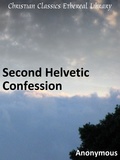Bible Knowledge Graph
Second Helvetic Confessio
- Entity ID:
- second-helvetic-confession
- Long Name:
- Second Helvetic Confession
- Short Name:
- Second Helvetic Confessio
- Disambiguation String:
- common belief of the Reformed churches of Switzerland
- Entity Type:
- work
- Entity Subtype:
- book
-

- Summary:
- The Second Helvetic Confession (Latin: Confessio Helvetica posterior) was written by Bullinger in 1562 and revised in 1564 as a private exercise. It came to the notice of Elector Palatine Frederick III, who had it translated into German and published. It was attractive to some Reformed leaders as a corrective to what they saw as the overly-Lutheran statements of the Strasbourg Consensus. "In early 1566 an attempt was made to have all the churches of Switzerland sign the Second Helvetic Confission as a common statement of faith."[1] It gained a favorable hold on the Swiss churches, who had found the First Confession too short and too Lutheran. Howevere, "the Basel clergy refused to sign the confession, stating that although they found no fault with it, they preferred to stand by their own Basel Confession of 1534."[2] It was adopted by the Reformed Church not only throughout Switzerland but in Scotland (1566), Hungary (1567), France (1571), Poland (1578), and after the Westminster Confession of Faith, the Scots Confession and the Heidelberg Catechism is the most generally recognized confession of the Reformed Church. The Second Helvetic Confession was also included in the United Presbyterian Church in the U.S.A.'s Book of Confessions, in 1967, and remains in the Book of Confessions adopted by the Presbyterian Church (U.S.A.). source: https://en.wikipedia.org/wiki/Helvetic_Confessions
- Viaf ID:
- 179058931
- DB Pedia ID:
- Helvetic_Confessions
- Is An Individual:
- No
- Is Published:
- Yes
- Original Language:
- lat
- LCCN:
- BX9429/H43
- CCEL URL:
- Original Language Title:
- confessio helvetica posterior
- LC Subjects:
- All; Symbols;
- Creators:
- Creator: Anonymous, Relator: aut, Creator ID: 1937
- Creator: E. W. Bullinger, Relator: aut, Creator ID: 12611
//ccel.org/creeds/helvetic.htm
